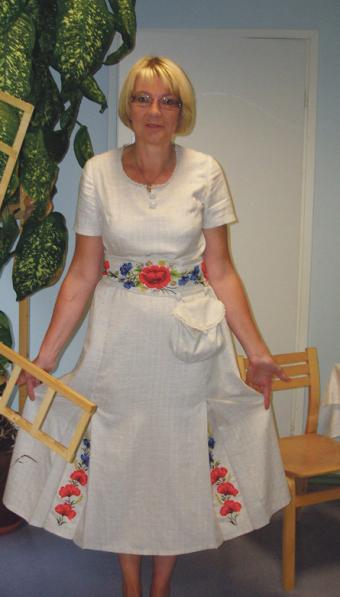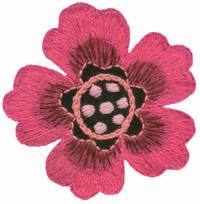Muhu Embroidery Stole Her Heart

This story, dedicated to a diligent woman for International Women’s Day, tells of Sirje Tüür, a native of Tallinn who now runs the Männiku Handicraft Workshop in the village of Koguva. Over time, she has become an enthusiastic embroiderer of Muhu patterns and a passionate teacher of this beautiful art to broad audiences.
Written by Vilma Rauniste, published in Meie Maa (Estonia)
Having married a local man, Sirje has long been welcomed into the Muhu community through her dedication and presence. This can be assumed even without conducting a public survey. When trying to reach her by phone, Sirje happened to be in Liiva, attending a gathering of the Oad ja Eed handicraft society, where she was formally presented with an honorary certificate and a monetary award for her contribution to developing handicrafts. A gift that, in a way, also served as a Women’s Day present. Upon hearing this, her five-year-old granddaughter in Tallinn cheerfully exclaimed, “Grandma got a poster!”
“It was a big surprise for me, as I’ve always thought that thank-you notes and honorary diplomas are given for truly special achievements, but handicraft is just part of my everyday life,” said Sirje, describing her astonishment. “But maybe they’ve noticed some of my new ideas? Perhaps that means the people of Muhu have accepted me. When it comes to learning and teaching, passing on local folk traditions and skills to the younger generation is extremely important—so that this beautiful heritage won’t be lost.”
The craftswoman shared that a few years ago, while touring Saaremaa, she didn’t notice any embroidered handicrafts in the tourist shops. “I thought to myself—there’s definitely room for growth. And today, I can say that many Saaremaa locals want to learn embroidery. It’s not rocket science—if you’ve got the interest and the will, it’s absolutely doable. But it takes an enormous amount of time. You have to practise and practise. Embroidery is much like top-level sport—if you want to reach the top and stay there, you have to train every day. Your wrist must always stay warm. I embroider every day. Sometimes I get told off—‘Hey, it’s Sunday!’ But I can’t help it—I love it so much.”
Weekends are for new thingsThese days, Sirje uses weekdays for commissioned work and weekends to embroider for herself. That’s usually when she embarks on something new and exciting. “I always want to try new things, to explore and experiment—there’s so much room for growth. I fear one lifetime won’t be enough. There are so many flowers around—I want to try embroidering all of them.”
Sirje came across an inspiring embroidery book from which she’s learning new techniques. She is currently experimenting with how to recreate dimensional embroidery—typically done with fine thread (mouliné)—using rustic wool yarn and satin stitch, while still achieving the same effect. She shows a so-called ‘sample patch’, which in reality is a large quilt, onto which she has embroidered many different flowers—both wild and cultivated. It’s like a beautifully designed floral alphabet—perfect for teaching children to identify flowers.
Creating recognisable flowers in embroidery isn’t as simple as it may seem. A small example: to successfully embroider globeflowers, Sirje and her husband Tõnis went into the forest, picked a bunch, took photographs, and then Sirje painted them on paper—only after that did she begin stitching them on fabric. “I had to get the feeling just right. Marigolds were another challenge—it took some effort to make the flower recognisable. In fact, this quilt began with a pansy, as I wanted to see how well it could be rendered in wool thread. With thick yarn, you just can’t blend tones in the same way.”
This flower-rich quilt is Sirje’s third. She refers to her quilts as her fourth pension pillar, since they’re so time- and labour-intensive that she couldn’t bear to sell them. “Maybe when I’m old and frail, and I no longer remember how much time and how many pricked fingers they cost me—maybe then I’ll be able to let them go.”
Many of Sirje’s embroidered pieces—sofa cushions, table runners, and more—have been professionally photographed and then digitally printed on fabric at a factory in Tallinn. This method allows her to offer beautiful designs at a more affordable price. For photography, she collaborates with Karli Foto and Andi Roos; for the actual production, she works with other Muhu artisans. Sewing work is handled by Triinu Traumann from Net Tikand, and Piret Lember provides slipper soles—whom Sirje says even outperforms her in that craft.
A look back at youthSirje was a 17-year-old city girl when she and two friends decided to apply to Tartu Art School. They needed to submit a sample piece. A friend’s mother suggested Muhu Island—a beautiful place with beaches, stone fences, and windmills. “We packed our painting supplies and headed to the island. We pitched our tent at Koguva beach, but word spread quickly that there were three girls camping there. That’s where I met a young man from Koguva, who drove his tractor to the beach before Midsummer’s Eve and invited one of us to help gather firewood. I agreed,” Sirje recalled the happy coincidence that shaped her life.
As a result, although she passed two entrance exams in Tartu, she chose to start a family instead and lived in Koguva for a while, where her first child, daughter Kristi, was born. Sirje was 18. Later came her son, Mihkel. “I started embroidering out of necessity—there were no jobs. When I lived in Muhu for nine months at 18, I started embroidering traditional slippers for the Uku company. But I also experienced emotional trauma. After moving back to Tallinn, I didn’t touch a needle for a long time. I had to meet production quotas while caring for a small child, often sacrificing sleep. Years later, when I returned to Muhu at 26, I first took up rug weaving, not embroidery. But people started asking, ‘Why aren’t you embroidering?’ And so it began. Now I think embroidery has become an addiction.”
It’s now been 11 years since Sirje left Tallinn behind. She raised and educated her children in the city, but every summer they spent holidays at her husband’s family farm in Koguva, where the to-do list was longer than the people. Upon returning to the island, Sirje was sure of one thing—she would never again take on salaried work, even though she didn’t yet know what she would do. Before moving, she had taken a variety of courses in Tallinn—learning weaving, silk painting, and ceramics.
In Muhu, she began with rug weaving, soon followed by silk painting. Both have since faded into the background. “Silk painting has been replaced with another kind of painting—on doors, window frames, planks of wood. Luckily, Tõnis lets me cover everything,” said the artistically inclined craftswoman. Her husband added that Sirje also paints ornaments and flowers onto the furniture he and his partner build—tailored to each client’s wishes.
Sirje sings her husband’s praises—he built their home, handles all the work, and lets her keep on embroidering, uninterrupted. It’s not unusual for him to cook and invite her to the table. “I’ve really struck gold with my husband. He can do everything. We’re both masters of our own time—we do what we want, when we want.” Tõnis compliments his hardworking wife, which has spared him the nagging found even in some posh households. So, daily life in the Tüür household is like a constant celebration of Women’s Day and a festival of flowers.
To end, here is the heroine’s own view on handicraft and Muhu Island: “I really only came into contact with handicraft here, on Muhu. It’s a fantastic place for creative work—a peaceful environment where you can think and create. I feel like it brings out something hidden in a person—something you wouldn’t have imagined possible. It’s just so cool!”
